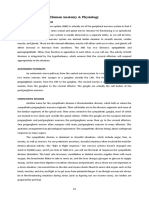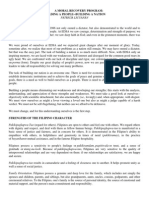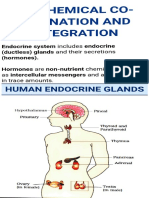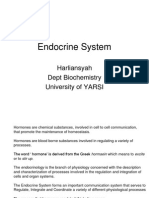Answers2e ch27
Answers2e ch27
Uploaded by
Pat ChuaCopyright:
Available Formats
Answers2e ch27
Answers2e ch27
Uploaded by
Pat ChuaOriginal Title
Copyright
Available Formats
Share this document
Did you find this document useful?
Is this content inappropriate?
Copyright:
Available Formats
Answers2e ch27
Answers2e ch27
Uploaded by
Pat ChuaCopyright:
Available Formats
Mastering Concepts
27.1
1. What is the overall function of an endocrine system?
The endocrine system is a communication system in an animals body.
2. Describe the relationship among endocrine glands, hormones, and target cells.
ndocrine glands are the organs responsible for producing and secreting hormones,
!hich are the biochemicals that travel through the blood to target cells containing
receptors for the hormone and that respond as a result of the hormone.
". What is the role of negative feedbac# in the endocrine system?
$egative feedbac# is the homeostatic mechanism that shuts off the stimulus that causes
hormone release so that hormone secretion ends.
%. &o! do the nervous and endocrine systems differ?
The endocrine and nervous systems have different rates of communication. $eural
communication is practically instantaneous, !hereas endocrine communication is much
slo!er and longer'lasting.
(. Describe ho! the nervous and endocrine systems interact.
)ne interaction bet!een the t!o is the hypothalamus that produces regulatory hormones
to directly or indirectly control many endocrine glands. The hypothalamus also ma#es
some hormones of the endocrine system.
27.2
1. &o! does a hormone affect some cells but not others?
* hormone !ill only affect target cells that have receptors for that hormone.
2. Describe the locations of the receptors that bind to !ater' and lipid'soluble hormones.
The receptors for !ater'soluble hormones are located in the cell membrane, !hereas
receptors for lipid'soluble hormones are located !ithin the cytoplasm or nucleus of the
target cells.
". What is the role of second messengers in hormone action?
The role of second messengers is to act !ithin the cell to activate the en+ymes that
produce the hormones effects.
%. ,plain the observation that peptide hormones usually act faster than steroid
hormones.
-eptide hormones usually act faster than steroid hormones because they activate chemical
cascades !ithin the cell. .n contrast, steroid hormones cross cell membranes and may
enter the nucleus and bind to a receptor on D$*. This !ill trigger the production of
proteins, !hich ta#es a fe! minutes. )r the steroid may bind to a receptor in the
cytoplasm and the combination travels to the nucleus to interact !ith D$*. ither
process ta#es more time than /ust triggering the activation of chemicals that are present
!ithin the cytoplasm.
27."
1. &o! does the hypothalamus interact !ith the posterior and anterior pituitary glands?
The hypothalamus controls secretions from the pituitary gland. 0eleasing hormones from
the hypothalamus stimulate the secretion of pituitary hormones, and inhibiting hormones
from the hypothalamus inhibit the secretion of anterior pituitary hormones. .n addition,
the hypothalamus secretes hormones that are then stored in the posterior pituitary.
2. 1ist the names and functions of the hormones released by the posterior and anterior
pituitary glands.
The posterior pituitary releases o,ytocin, !hich stimulates smooth muscle contraction in
the uterus and mammary glands. The posterior pituitary also releases *D&, !hich
promotes !ater conservation in the #idney. The anterior pituitary secretes 2& to
stimulate tissue gro!th, prolactin to stimulate mil# production, T3& to stimulate the
release of thyroid hormones, *4T& to stimulate the release of glucocorticoid hormones
from the adrenal corte,, 53& and 1& to stimulate se, cell production and se, hormone
release, and peptides to act on pain relief at receptors in the brain.
27.%
1. What are the three hormones produced in the thyroid, and !hat are their functions?
Thyroid hormones include6
' thyro,ine6 increases the rate of metabolism in cells7
' triiodothyronine6 increases the rate of metabolism in cells7
' calcitonin6 increases the rate at !hich calcium is deposited in bone.
2. What is the function of parathyroid hormone 8-T&9?
-T& increases calcium levels in blood and tissue fluid by increasing calcium release from
bones and by increasing calcium absorption into the blood from the digestive tract and
#idneys.
". &o! do the functions of hormones secreted by the adrenal corte, and adrenal medulla
differ?
&ormones secreted by the adrenal corte, 8glucocorticoids and mineralocorticoids9
suppress the immune system, are important in the bodys response to prolonged stress,
and maintain blood volume and salt balance. &ormones secreted by the adrenal medulla
8epinephrine and norepinephrine9 are important in the bodys response to short'term
stress. They increase the heart rate, breathing rate, blood flo!, and blood glucose and
shunt blood to!ard the brain and muscles.
%. Describe the opposing roles of insulin and glucagon.
:oth insulin and glucagon affect the level of glucose in the blood, but they have opposite
effects. .nsulin removes glucose from the bloodstream by stimulating cells to absorb it.
2lucagon stimulates liver cells to release glucose into the bloodstream.
(. &o! do dar#ness and light affect melatonin secretion?
Dar#ness stimulates melatonin production, !hereas light inhibits melatonin synthesis in
the pineal gland.
27.(
1. Which organs contain target cells for 53& and 1&?
The testes and the ovaries contain receptors for 53& and 1&.
2. What are the functions of estrogen, progesterone, and testosterone?
strogen promotes the development of female secondary se, characteristics and inhibits
secretion of 2n0& from the hypothalamus. -rogesterone maintains a pregnancy. .t also
inhibits secretion of 2n0& from the hypothalamus, !hich inhibits the production of 1&
and 53&. Testosterone produces male secondary se, characteristics and inhibits the
production of 1& and 53&.
27.;
1. 3ummari+e the evidence for an evolutionary relationship bet!een fish gills and a
chic#ens parathyroid glands.
5irst is the location of the parathyroid gland, !hich is similar to the location of gills in
fish. 3econd, both gills and the parathyroid gland originate from an embryonic structure
#no!n as a pharyngeal gill slit. Third, the same gene, Gcm-2, is re<uired for gill
development in the Danio and parathyroid development in mice.
2. &o! do you thin# the embryos in figure 27.1; !ould loo# if the probe indicated
e,pression of a gene re<uired for cellular respiration?
3ince cellular respiration is necessary for every cell to produce *T-, the entire embryo
!ould be dar# blue.
Write It Out
1. &o! does the endocrine system interact !ith the nervous system? The circulatory
system?
The nervous and endocrine systems are tightly integrated. 5or e,ample, some chemicals
can act as both neurotransmitters and hormones. 3ome neurons in the hypothalamus, a
brain structure that lin#s the nervous and endocrine systems, release hormones. .n
addition, neurotransmitters and hormones share some target cells. The endocrine system
interacts !ith the circulatory system by releasing hormones into the bloodstream.
2. * <ueen honeybee secretes a substance from a gland in her mouthparts that inhibits the
development of ovaries in !or#er bees. .s this substance most li#ely a hormone, a
neurotransmitter, or a pheromone? 4ite a reason for your ans!er.
The chemical !ould most li#ely be a pheromone, !hich is a communication molecule
that transmits signals to other individuals. &ormones and prostaglandins are
communication molecules that act !ithin the body of a single organism.
". What prevents a hormone from affecting all body cells e<ually?
* hormone e,erts a physiological effect only on target cells that have specific receptors
for the hormone.
%. =any dairy operators in/ect their co!s !ith bovine gro!th hormone to stimulate mil#
production. 4ite t!o reasons that bovine gro!th hormone might not stimulate gro!th in
people drin#ing the mil#.
:ovine gro!th hormone !ould probably not interact !ith receptors on target cells in
humans, because bovine gro!th hormone probably has a slightly different shape than
human gro!th hormone. .n addition, bovine gro!th hormone in mil# could be destroyed
in a persons digestive system and never enter the bloodstream.
(. &o! do hormones regulate their o!n levels?
$egative feedbac# loops ensure that the levels of a hormone in the bloodstream are not
too high or too lo!. .n a positive feedbac# loop, the presence of a hormone increases its
production.
;. 4ompare and contrast the endocrine and nervous systems.
The nervous and endocrine systems both interact to maintain homeostasis, and both rely
on chemicals for communication 8i.e. neurotransmitters and hormones9. The nervous
system acts faster and more locally than the endocrine system.
7. 3#etch the mechanisms of peptide and steroid hormone function.
>*ns!er !ill be visual. 0efer to figure 27.%.?
@. 1ist the hormones released from the posterior pituitary and the anterior pituitary.
The posterior pituitary releases antidiuretic hormone 8*D&9 and o,ytocin. The anterior
pituitary gland releases gro!th hormone, prolactin, follicle'stimulating hormone 853&9,
luteini+ing hormone 81&9, thyroid'stimulating hormone 8T3&9, and adrenocorticotropic
hormone.
A. &o! are the pituitary and adrenal glands each really t!o glands in one?
The pituitary gland has both an anterior and posterior portion, each !ith different
functions and made of different types of tissue. The adrenal gland has a medulla that
secretes different hormones from the adrenal corte,.
1B. Which hormone8s9 match each of the follo!ing descriptions?
a. -roduced by a !oman !ho is breast feeding
b. 4auses fatigue if too little is present
c. 4auses increase in blood calcium level
d. 4auses decrease in blood glucose level
e. 3ynthetic steroid drugs mimic the muscle'building effects of this
hormone.
8a9 -rolactin. 8b9 .nsulin and thyro,ine 8metabolism is affected9. 8c9 -arathyroid
hormone 8-T&9. 8d9 .nsulin. 8e9 Testosterone.
11. Describe ho! thyro,ine, triiodothyronine, T3&, and T0& interact.
When levels of thyro,ine and triiodothyronine are lo!, the hypothalamus releases T0&,
!hich stimulates cells in the anterior pituitary gland to secrete T3&. T3& travels in the
bloodstream and stimulates cells in the thyroid gland to produce and secrete thyro,ine
and triiodothyronine.
12. *ncient gyptian doctors treated goiters !ith sea!eed, not reali+ing that it !as the
iodine in the sea!eed that !as reversing the condition. Why !ould iodine help cure a
goiter?
.odine is needed by the thyroid to produce the thyroid hormones. 1o! iodine is the cause
of the s!ollen thyroid gland.
1". Why !ould a physician counsel a patient !ith high blood pressure to try to reduce the
amount of stress in his or her life?
.n response to stress, the adrenal medulla releases epinephrine and norepinephrine, both
of !hich elevate blood pressure and heart rate. *lso, the adrenal corte, releases
glucocorticoids in response to long'term stress. 2lucocorticoids, such as cortisol,
constrict blood vessels, increasing blood pressure.
1%. 3leep deprivation increases cortisol concentrations in the blood. Why !ould sleep
deprivation be associated !ith increased ris# of illness?
3ecretion of the steroid hormone cortisol leads to a depression of the immune system.
1(. 3earch the .nternet for a diabetes ris# test. What actions can you ta#e to reduce your
ris# of type 2 diabetes?
The t!o main actions you can ta#e to prevent type .. diabetes are eating healthy and
increasing e,ercise.
1;. &o! might insulin'producing stem cells transplanted to the pancreas help people !ith
type 1 diabetes? Would the same treatment help people !ith type 2 diabetes?
.n type . diabetes, beta cells in the pancreas do not produce insulin !hen stimulated. The
insulin'producing stem cells !ould correct this disorder. .n type .. diabetes, ho!ever,
beta cells produce insulin, but the bodys cells do not respond to it. The stem cell
treatment !ould not help in this case.
17. .n healthy adults, the concentration of glucose in blood is appro,imately @B to 11B
milligrams per deciliter 8mgCdl9. *fter a carbohydrate'rich meal, ho!ever, the
concentration may spi#e to 1%B mgCdl.
a. Describe the hormonal action that returns blood glucose to normal
after a meal.
b. What is the name for the condition in !hich the glucose
concentration drops belo! 7B mgCdl?
c. What is the name for the condition in !hich the glucose
concentration before a meal is 1"B mgCdl or higher?
a9 *fter a meal, blood glucose levels rise stimulating the release of insulin from the
pancreas. The insulin signals body cells to absorb the glucose, lo!ering the blood glucose
levels and ending the release of insulin. b9 :lood glucose levels belo! 7B mgCdl are
referred to as hypoglycemia. c9 :lood glucose levels above 1"B mgCdl are referred to as
hyperglycemia.
1@. .dentify the target cells and effects of 53&, 1&, estrogen, progesterone, and
testosterone.
53& targets cells in the ovaries and testes to stimulate sperm and egg production. 1&
targets cells in the ovaries and testes to produce the se, hormones. strogen targets the
uterus and brain to regulate menstruation and secondary se, characteristics. -rogesterone
targets the uterus to prepare for pregnancy and the brain to regulate menstruation.
Testosterone targets cells in the embryo to stimulate male development. Testosterone also
targets cells in the body, maintaining secondary se, characteristics in males.
1A. .magine you are a researcher !ho has /ust found a small glandli#e structure in a
human. &o! !ould you determine !hether it is an endocrine gland? .f it is, ho! might
you identify the glands role in the endocrine system?
ndocrine glands secrete hormones directly into the bloodstream7 anatomically, they lac#
ducts. ,amining the chemical composition of the structures secretions !ould help
determine !hether it !as producing hormones. .f it is an endocrine gland, a researcher
can learn more about its function by tagging the hormone !ith a tracer and determining
!hich target cells else!here in the body bind to the hormone. *nother !ay to learn about
the glands role !ould be to surgically remove the gland and observe the effects on the
organism.
2B. 4onsult chapter 2( and this chapter to create a chart comparing hormones !ith
neurotransmitters. .nclude the distance over !hich each is active, the connection bet!een
the cell releasing signals and the receiving cell, the response speed, and the duration of
the response.
4haracteristic $eurotransmitter &ormone
Distance active over Dery narro!'the synaptic
cleft
2reat distancesEas far as
the pituitary to the ovaries
4onnection bet!een
releasing and receiving cell
* synapse :lood flo!
0esponse speed 5ractions of a second =inutes, hours or days
Duration of response 5ractions of a second -rolonged
21. *n endocrine disruptor is a molecule that either mimics or bloc#s the activity of a
hormone. =any synthetic chemicals are endocrine disruptors. -ropose a !ay to test the
hypothesis that6
a. a pesticide such as atra+ine is an endocrine disruptor.
b. endocrine disruptors are responsible for recent declines in human
sperm counts.
c. micro!aving foods in plastic containers releases chemicals that act
as endocrine disruptors.
>*ns!ers !ill vary, but each e,periment should include a treatment group, a control
group, and standardi+ed variables.?
22. 3ome people advocate treating severely disabled children !ith hormones that prevent
gro!th, since a small person is much easier to clothe and bathe than a full'gro!n adult.
What factors !ould you consider in deciding !hether to pursue such a treatment for a
disabled child?
=ultiple ans!ers are possible, but it !ould certainly be important to consider the side
effects of the treatments, since many hormones have multiple effects on the body. The
physical condition of the caregivers may be relevant as !ell. 5inally, consider the ethics
of manipulating ones gro!th and development for the convenience of another.
Pulling it Together
1. Describe a negative feedbac# loop that controls hormone secretion.
Thyroid hormones are regulated by a negative feedbac# loop. When the hypothalamus
detects lo! concentrations of thyroid hormone, the hypothalamus increases secretion of
thyroid releasing hormone 8T0&9. When the anterior pituitary detects T0&, it increases
secretion of thyroid stimulating hormone 8T3&9, !hich increases the release of hormones
from the thyroid gland. .f the concentration of thyroid hormone becomes too high, the
hypothalamus decreases secretion of T0&, !hich decreases the anterior pituitarys
secretion of T3&, !hich, in turn, decreases the release of hormones from the thyroid
gland.
2. What brain structure connects the endocrine and nervous systems?
The hypothalamus is part of the forebrain. .t is intimately connected !ith the pituitary
gland, !hich connects the brain !ith the endocrine system.
". Describe the relationship among the hypothalamus, pituitary, and other endocrine
glands.
&ypothalamus receives informative signals from the bloodstream and the brain. .t sends
neural and hormonal signals to the pituitary gland, !hich is /ust belo! the hypothalamus.
The pituitary gland relays regulatory signals to other endocrine glands, including the
pancreas, adrenal gland, thyroid gland, pineal gland and testes or ovaries. These glands
respond to signals from the hypothalamus and pituitary, releasing their o!n hormones to
the systems and organs they regulate. :y having this design, a single signal from the
brain can affect many systems, !hile feedbac# loops maintain homeostasis.
You might also like
- 2022 PRITE Question-BookDocument244 pages2022 PRITE Question-Booknnzr1996No ratings yet
- CH 03Document13 pagesCH 03Fernando MoralesNo ratings yet
- Yoga Psychology 01.ppsDocument38 pagesYoga Psychology 01.ppsDanilo MendesNo ratings yet
- CH 45Document9 pagesCH 45homamunfatNo ratings yet
- Endocrine SystemDocument3 pagesEndocrine SystemRosario ArroyoNo ratings yet
- hormone (1)Document39 pageshormone (1)hgtfggyyvNo ratings yet
- Science & English G10 Activities SamplesDocument6 pagesScience & English G10 Activities SamplesShane RicoNo ratings yet
- What Is Human Endocrine SystemDocument38 pagesWhat Is Human Endocrine SystemNatukunda DianahNo ratings yet
- Human Anatomy and Physiology - The Endocrine SystemDocument5 pagesHuman Anatomy and Physiology - The Endocrine SystemKraig Andre RellegueNo ratings yet
- S.3 COORDINATION By Hassan BiosDocument24 pagesS.3 COORDINATION By Hassan BioskiyembataishirNo ratings yet
- Basic Endocrinology Questions-1Document15 pagesBasic Endocrinology Questions-1Lili rayNo ratings yet
- المحاضرةالثانية 3كيمياء حيويDocument21 pagesالمحاضرةالثانية 3كيمياء حيويkhodaira2010No ratings yet
- HormoneDocument16 pagesHormonemhamadnaby66No ratings yet
- Endocrine System Group 9Document77 pagesEndocrine System Group 9Jei SanNo ratings yet
- Endocrine SystemDocument20 pagesEndocrine SystemK8Y KattNo ratings yet
- unit 4 (2)Document9 pagesunit 4 (2)Koena GulabaniNo ratings yet
- MODULE 1 Assessment of The Endocrine SystemDocument31 pagesMODULE 1 Assessment of The Endocrine SystemLorraine GambitoNo ratings yet
- IntroDocument45 pagesIntrowaqasNo ratings yet
- Topic 1 Endocrine SystemDocument140 pagesTopic 1 Endocrine SystemmasdfgNo ratings yet
- Chemical Control and OordinationDocument5 pagesChemical Control and OordinationprimeeducationalinstituteNo ratings yet
- The Endocrine SystemDocument37 pagesThe Endocrine SystemM Shafique SadiqeeNo ratings yet
- Introductiontohormones1 200330171537Document24 pagesIntroductiontohormones1 200330171537bhavyapandit0408No ratings yet
- 3.2 Endocrine SystemDocument11 pages3.2 Endocrine SystemreddyapdscNo ratings yet
- Adrenocorticotropic Hormone (ACTH) From The Anterior Pituitary Gland Specifically StimulatesDocument2 pagesAdrenocorticotropic Hormone (ACTH) From The Anterior Pituitary Gland Specifically StimulatesStjepan ErženNo ratings yet
- Endocrine System Endocrine System: "The Body Regulator"Document31 pagesEndocrine System Endocrine System: "The Body Regulator"angelus008No ratings yet
- Hormones:: Signaling MoleculesDocument20 pagesHormones:: Signaling MoleculesSangeeta DwivediNo ratings yet
- Endocrine_notesDocument14 pagesEndocrine_notessaiabhinay9No ratings yet
- The Endocrine System: An OverviewDocument12 pagesThe Endocrine System: An Overviewlovelyc95No ratings yet
- SGD Physiology Endocrine and MetabolismDocument7 pagesSGD Physiology Endocrine and MetabolismTinesh RajahNo ratings yet
- Endocrine Glands - Definition Examples Function Biology DictionaryDocument7 pagesEndocrine Glands - Definition Examples Function Biology Dictionaryrania khanNo ratings yet
- UntitledDocument12 pagesUntitledDerrick kinyaNo ratings yet
- Endocrine Anatomy and PhysiologyDocument10 pagesEndocrine Anatomy and PhysiologyJojo JustoNo ratings yet
- Learning JournalDocument82 pagesLearning JournalAnnapurna RavelNo ratings yet
- Madocs AnaphyDocument2 pagesMadocs AnaphyariespatrickNo ratings yet
- Introduction To Endocrinology and Mechanism of Actions of HormobesDocument16 pagesIntroduction To Endocrinology and Mechanism of Actions of Hormobeseduviere46No ratings yet
- Introduction To Endocrinology: Dr. Jehad Al-ShuneigatDocument21 pagesIntroduction To Endocrinology: Dr. Jehad Al-Shuneigatyousef sarairehNo ratings yet
- Module 3Document19 pagesModule 3VENTURA, ANNIE M.No ratings yet
- CBSE Quick Revision Notes (Class-11 Biology) Chapter-22 Chemical Coordination and IntegrationDocument3 pagesCBSE Quick Revision Notes (Class-11 Biology) Chapter-22 Chemical Coordination and IntegrationNANDAKUMAR BABUNo ratings yet
- CBSE Quick Revision Notes (Class-11 Biology) Chapter-22 Chemical Coordination and IntegrationDocument3 pagesCBSE Quick Revision Notes (Class-11 Biology) Chapter-22 Chemical Coordination and IntegrationNANDAKUMAR BABUNo ratings yet
- Introduction To EndocrinologyDocument12 pagesIntroduction To EndocrinologyBunny OzuNo ratings yet
- Human Anatomy & Physiology: Autonomic Nervous SystemDocument8 pagesHuman Anatomy & Physiology: Autonomic Nervous SystemBeth EchavezNo ratings yet
- GROUP 9 Edocrine System ReportDocument52 pagesGROUP 9 Edocrine System Reportroyeth montezaNo ratings yet
- Endokrin MW DitransletDocument7 pagesEndokrin MW DitransletSanta SaintNo ratings yet
- System Glands Hormone: NeurotransmittersDocument6 pagesSystem Glands Hormone: NeurotransmittersShaheryar HasanNo ratings yet
- 22.chemical Coordination and Integration-FDocument25 pages22.chemical Coordination and Integration-FMidhun Bhuvanesh.B 7ANo ratings yet
- EXCI360 Ch75 IntroductionDocument21 pagesEXCI360 Ch75 Introduction5xfz6hjkpgNo ratings yet
- ENDOCRINE SYSTEM - Anatomy and PhysiologyDocument10 pagesENDOCRINE SYSTEM - Anatomy and PhysiologyJay Crishnan Morales CajandingNo ratings yet
- Module 5Document10 pagesModule 5Jayvee VillaramaNo ratings yet
- Endocrine System Anatomy and Physiology - NurseslabsDocument29 pagesEndocrine System Anatomy and Physiology - NurseslabsAlyssum Marie50% (2)
- 1016MSC T1 2023 Module 5 Tutorial WorksheetsDocument21 pages1016MSC T1 2023 Module 5 Tutorial WorksheetsTina HussainiNo ratings yet
- Grow Taller: © Dr. Laura de Giorgio All Rights ReservedDocument12 pagesGrow Taller: © Dr. Laura de Giorgio All Rights ReservednepplutoNo ratings yet
- 28753Document20 pages28753Komal NadeemNo ratings yet
- Endocrine System 1 PDFDocument10 pagesEndocrine System 1 PDFDilNo ratings yet
- 5 Therio Lecture 5 Hormones of reproductionDocument15 pages5 Therio Lecture 5 Hormones of reproductionDhugomsa ZeynoNo ratings yet
- Lesson Plan For Anatomy and PhysiologyDocument7 pagesLesson Plan For Anatomy and PhysiologyJamie Bagundol100% (1)
- Endocrine System -Group 6Document9 pagesEndocrine System -Group 6breboneriakayeNo ratings yet
- EXCI360 Ch75 IntroductionDocument19 pagesEXCI360 Ch75 Introduction5xfz6hjkpgNo ratings yet
- Assignment #2: Technological Institute of The PhilippinesDocument4 pagesAssignment #2: Technological Institute of The PhilippinesMarvin ParasNo ratings yet
- Module 3Document20 pagesModule 3VENTURA, ANNIE M.No ratings yet
- Chemical Control and IntegrationDocument40 pagesChemical Control and IntegrationdiyNo ratings yet
- Endocrine SystemsDocument36 pagesEndocrine Systemsofficiallanarhoades16No ratings yet
- Anatomy and Physiology: The Endocrine System: Things You Should Know (Questions and Answers)From EverandAnatomy and Physiology: The Endocrine System: Things You Should Know (Questions and Answers)No ratings yet
- Endocrine System: A Tutorial Study GuideFrom EverandEndocrine System: A Tutorial Study GuideRating: 5 out of 5 stars5/5 (1)
- Soc Ant Paper OKK!Document2 pagesSoc Ant Paper OKK!Pat ChuaNo ratings yet
- Pangit Ni TeeDocument2 pagesPangit Ni TeePat ChuaNo ratings yet
- Mia Soliman - Hetar (Ref)Document1 pageMia Soliman - Hetar (Ref)Pat ChuaNo ratings yet
- Making Sense of Abstract TheoriesDocument4 pagesMaking Sense of Abstract TheoriesPat ChuaNo ratings yet
- Functional Group ThiolsDocument3 pagesFunctional Group ThiolsPat ChuaNo ratings yet
- A Moral Recovery ProgramDocument13 pagesA Moral Recovery ProgramPat Chua100% (1)
- Hello GandaDocument1 pageHello GandaPat ChuaNo ratings yet
- EndocrinologyDocument46 pagesEndocrinology[161]Shuaib AktherNo ratings yet
- Endocrine Pathology - UntadDocument158 pagesEndocrine Pathology - UntadfahrulrozyNo ratings yet
- NURSING ANAPHY Lec Session #12 - SAS (NEW FORMAT) PDFDocument2 pagesNURSING ANAPHY Lec Session #12 - SAS (NEW FORMAT) PDFKriztel Andrei Lapac NavajaNo ratings yet
- Chemical Co - OrdinationDocument21 pagesChemical Co - OrdinationManinder KaurNo ratings yet
- Endocrine SystemDocument8 pagesEndocrine SystemAref DahabrahNo ratings yet
- Thermoregulation: Presenter: Dr. Faisal Djamil Sheriff, H58/38054/2020 Moderator: Dr. MuriithiDocument56 pagesThermoregulation: Presenter: Dr. Faisal Djamil Sheriff, H58/38054/2020 Moderator: Dr. MuriithiHarshilPatelNo ratings yet
- Hindbrain Neurons As An Essential Hub in The Neuroanatomically Distributed Control of Energy BalanceDocument14 pagesHindbrain Neurons As An Essential Hub in The Neuroanatomically Distributed Control of Energy BalanceAnton PatriaNo ratings yet
- Kevin Murphy PHD ThesisDocument5 pagesKevin Murphy PHD Thesisnadinebenavidezfortworth100% (2)
- From Toads To Queens Transvestism in A Latin SettingDocument150 pagesFrom Toads To Queens Transvestism in A Latin Settingcool_AZNo ratings yet
- (Template) Lab Report TemplateDocument16 pages(Template) Lab Report TemplateArunima 620006No ratings yet
- The Endocrine System An OverviewDocument12 pagesThe Endocrine System An OverviewANDREA SANDOVAL BRIANONo ratings yet
- Biological Basis of Emotions1Document10 pagesBiological Basis of Emotions1ankitaNo ratings yet
- Advances in Vasopressin and Oxytocin From Genes To Behaviour To Disease PDFDocument582 pagesAdvances in Vasopressin and Oxytocin From Genes To Behaviour To Disease PDFkawaNo ratings yet
- Biological Basis of HomosexualityDocument4 pagesBiological Basis of HomosexualityNeo OneNo ratings yet
- Roles of Endocrine and Nervous System in HomeostasisDocument11 pagesRoles of Endocrine and Nervous System in Homeostasislekansamuel2005No ratings yet
- Endocrine GlandsDocument9 pagesEndocrine Glandstadashii100% (1)
- Endocrine GlandsDocument3 pagesEndocrine Glandsdan 123No ratings yet
- 337 Pdfsam NMS PhysiologyDocument166 pages337 Pdfsam NMS PhysiologydrpnnreddyNo ratings yet
- Advanced Master Degree Clinical Neuropsychology NeuroeducationDocument64 pagesAdvanced Master Degree Clinical Neuropsychology NeuroeducationAnanth Venkata RamanNo ratings yet
- Dr. Ric Guanzon - Science of COVID-19Document92 pagesDr. Ric Guanzon - Science of COVID-19Renee Lyn Cruz PaderesNo ratings yet
- Biokimia1 EndokrinDocument26 pagesBiokimia1 EndokrinJuwitaNo ratings yet
- Preventive Dermatology, Norman, 2010 PDFDocument310 pagesPreventive Dermatology, Norman, 2010 PDFAna Maria Ludu100% (1)
- Final Exam in Anatomy and PhysiologyDocument6 pagesFinal Exam in Anatomy and PhysiologyKeanu Ribs100% (3)
- Download Complete Basic endocrinology for students of pharmacy and allied health sciences 1st Edition Bartke PDF for All ChaptersDocument81 pagesDownload Complete Basic endocrinology for students of pharmacy and allied health sciences 1st Edition Bartke PDF for All Chaptersjephjasiu100% (4)
- Change in AR-ER-sex BehavDocument24 pagesChange in AR-ER-sex BehavNandia SeptiyoriniNo ratings yet
- Oral Physioloy Lecture 1 PDFDocument33 pagesOral Physioloy Lecture 1 PDFHabeeb AL-AbsiNo ratings yet
- VOL 3 - Layout 1Document596 pagesVOL 3 - Layout 1Raluca Crina100% (1)
































































































